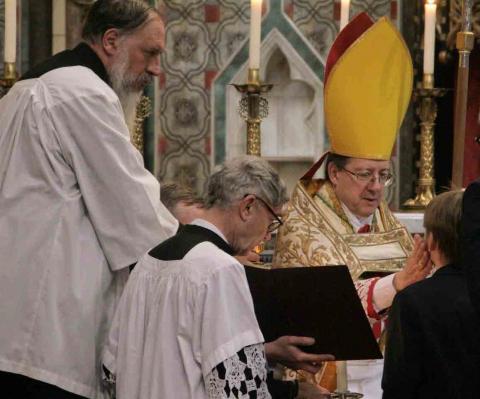
The Sacrament of Confirmation completes the initiation begun by Baptism: in the customary words of the catechisms, it makes the candidate a ‘perfect’ Christian, not in the sense of being sinless, but in the sense of ‘complete’. The significance of this is that the candidate becomes a ‘soldier of Christ’. All the baptized, and for that matter those preparing for baptism, are obliged to engage in the unceasing war which the devil wages to capture human souls. The stages of initiation indicate stages of readiness for the more dangerous sections of the front line. Catholics must be confirmed in order to be ordained, or to make religious vows. They are earnestly exhorted to be confirmed before getting married, even if this is not an absolute requirement (Canon 1065.1). One way this aspect of Confirmation is made clear in the Traditional Rite is that, after signing the candidate on the forehead with oil of chrism, the bishop (or a priest with special faculties) gives the candidate a slight blow on the cheek - a ‘slap’, as it is sometimes called. At the ceremony organized by the Latin Mass Society in St James’, Spanish Place, last year, Bishop John Sherrington explained that this symbolizes the candidate’s willingness to suffer for the Faith.
The slap was removed from the reformed ceremony in 1971, although it seems that it is sometimes still done in the Ordinary Form. Being slapped on the cheek might seem an odd way to symbolize a willingness to suffer, and there is of course more to it than that. The blow on the cheek after the anointing appears in liturgical books in the Middle Ages, and is a liturgical version of the ‘colée’, the blow on the cheek given to new knights in many versions of the knighting ceremony. This is the equivalent to the blow (or touch) to the shoulders with a sword which The Queen uses to ‘dub’ a new knight to this day. The connection with knighting was made explicit by a Church spokesman at the time the slap was removed from the Confirmation rite. The New York Times reported on 14 September 1971: “At a news conference, the Very Rev. Aime-Georges Martimort, an official of the Vatican department in charge of divine worship, said that the reform also dropped the comparatively modern usage of giving the person being confirmed a slight blow on the cheek. He explained that the ritual recalled the conferring of knighthood by a symbolic stroke with a sword”.
Martimort was in fact a serious liturgical scholar, but we might quibble with his description of the ritual blow as ‘comparatively modern’: it appears in liturgical books edited by William Durandus, who died in 1296. What, then, does the blow on the cheek mean in the context of the knighting ceremony? The common interpretation of it is this: a blow on the cheek is an insult, and this is the last insult which the new knight will receive without defending his honour. In other words, the blow symbolizes a knight’s induction into the knightly code of honour. From then on, his honour, his reputation, is more important to him than anything. Although the honour code could be misused, at its best it meant that the knightly ideals of defending the innocent and upholding truth weighed more heavily for the knight than any considerations of titles, wealth, or personal safety. The Duke of Norfolk explains it to the King in Shakespeare’s play, Richard II: “Myself I throw, dread sovereign, at thy foot. My life thou shalt command, but not my shame: The one my duty owes; but my fair name, Despite of death that lives upon my grave, To dark dishonour’s use thou shalt not have." The Duke would die for his king: but not be disgraced for his king.
What, then, is the significance of importing the colée into the ritual of the Sacrament of Confirmation? It means two things. First, the confirmand is understood to be taking up an officer’s rank, so to speak, in Christ’s spiritual army. Second, this rank implies a special obligation. A civilian who flees an invading army is not thereby dishonoured; an officer, commanded to resist it, would be. In the case of Catholics, the special obligation is not the use of violence, but the profession of the Faith. An articulated, verbal profession of the Faith may be required of us from time to time, when we are faced with a sincere inquirer or, by contrast, with an attack on the Faith which we cannot allow to go unanswered. A different kind of profession, however, is more fundamental, and is required throughout our lives: that of living the Faith. We are called to live a public lifestyle in accordance with the Faith: even if it is, inevitably, marred by sin, it should not be a lifestyle shaped by compromise with sin. This is not always an easy matter. Doing a job involving formal (willed) cooperation with sin, living a life of public scandal, failing as a married person to be open to life, failing to frequent the sacraments, failing to undertake good works: such lifestyles are incompatible with the honour of a knight in Christ’s army. Such public failures go beyond private sins in their effects on others, both other Catholics, who are disheartened, and to non-Catholics, who can get the impression that Catholics are hollow hypocrites. In living in these ways, we turn tail and flee the difficulties demanded of us as soldiers of Christ.
The Sacrament of Confirmation, if received with the proper dispositions, gives us the graces we need to profess the Faith by our lives, in the face of all kinds of temptation and pressure. No Catholic should go to the front-line of modern life without it.
